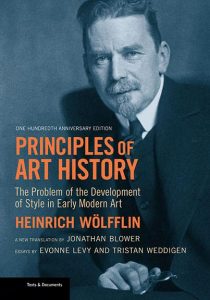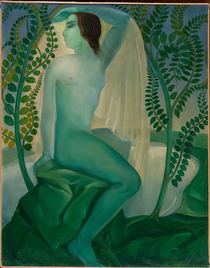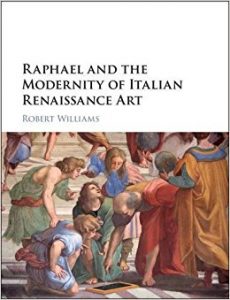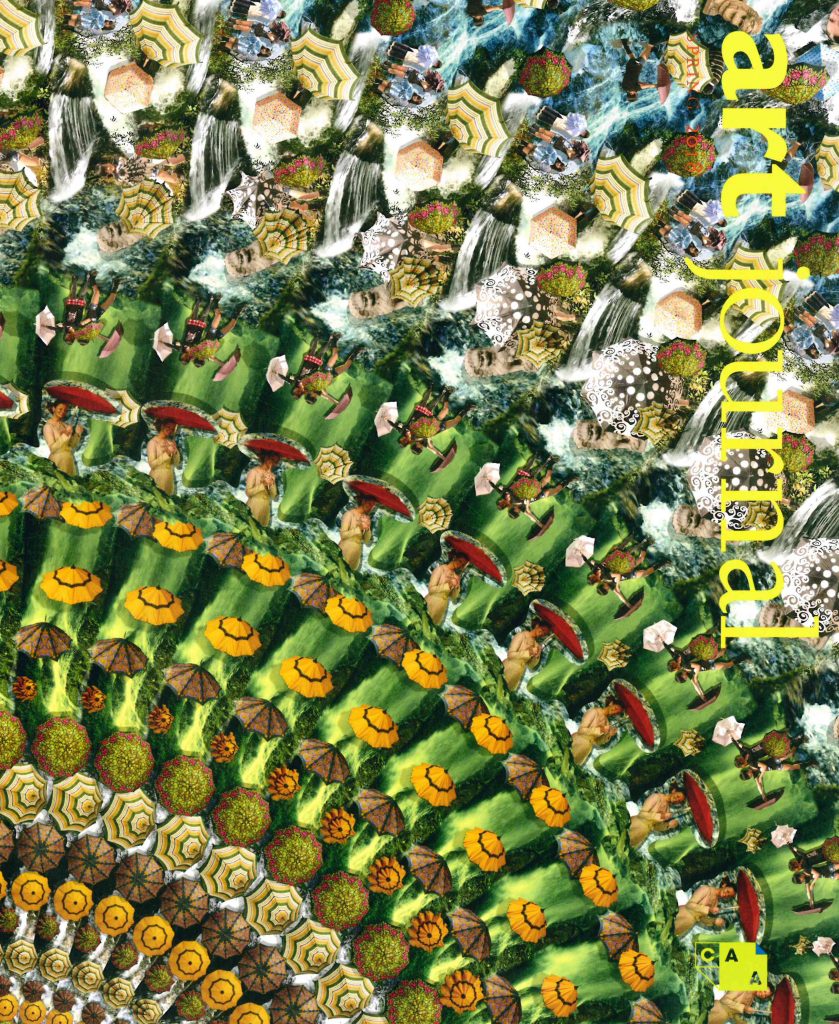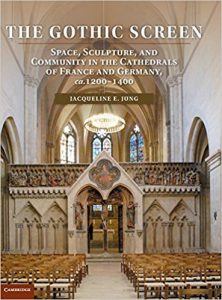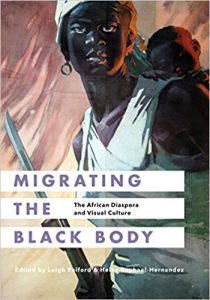CAA News Today
Kevin Curry and Christopher McNulty
posted by CAA — May 21, 2018
The weekly CAA Conversations Podcast continues the vibrant discussions initiated at our Annual Conference. Listen in each week as educators explore arts and pedagogy, tackling everything from the day-to-day grind to the big, universal questions of the field.
This week, Kevin Curry and Christopher McNulty discuss the challenges and benefits of digital technology in 3D/Sculpture.
Kevin Curry is an Associate Teaching Professor at Florida State University where he teaches digital foundations and sculpture. He’s currently in London teaching a photo for non-majors class.
Christopher McNulty is Professor of Art in the Department of Art & Art History at Auburn University in Alabama and teaches sculpture to undergraduates at all levels. He is a dual citizen of France and the United States.
New in caa.reviews
posted by CAA — May 17, 2018
Todd Cronan writes about Principles of Art History: The Problem of the Development of Style in Early Modern Art by Heinrich Wölfflin. Read the full review at caa.reviews.
Monique Kerman reviews Phenomenal Difference: A Philosophy of Black British Art by Leon Wainwright. Read the full review at caa.reviews.
Yulia Karpova discusses Gruzinskii avangard: 1900–1930 by Iveta Manasherova and Elena Kamenskaya, and the exhibition The Georgian Avant-garde: 1900–1930s: Pirosmani, Gudiashvili, Kakabadze, and Other Artists at the Pushkin State Museum of Fine Arts. Read the full review at caa.reviews.
Christian K. Kleinbub explores Raphael and the Redefinition of Art in Renaissance Italy by Robert Williams. Read the full review at caa.reviews.
Announcing New Benefits for CAA Individual Members
posted by CAA — May 16, 2018

CAA is proud to announce a new suite of benefits for its members starting today. As an association concerned with supporting all aspects of its members’ lives, we are adding a series of benefits to your CAA membership that help you when you travel, with your insurance needs, and with technology and design programs. The full details about these new membership benefits will be behind the CAA membership wall shortly, but they are also ready to use now at the links below.
If you have any questions don’t hesitate to contact our membership services team at Member Services at 212-691-1051, ext. 1.
Hilton Hotels
Get discounts on your room rates when you stay at a Hilton or any of the hotels in the Hilton Hotel family.
Learn more about Hilton hotel discounts
- 10% discount at Hilton full service hotels, and 6% discount at Hilton focus service hotels, non-last room availability (NRLA) Discount
- Full Service hotels include: Waldorf Astoria Hotels & Resorts; Conrad Hotels & Resorts; Canopy by Hilton; Curio by Hilton; Hilton Hotels & Resorts; DoubleTree by Hilton; Tapestry by Hilton; and Embassy Suites by Hilton
- Focus Service Hotels include: Hilton Garden Inn; Hampton by Hilton; Homewood Suites by Hilton; Home2 by Hilton; and Tru by Hilton.
*Discounts not available during CAA Annual Conference
MetLife
Get discounts on Home, Auto, and Dental insurance with MetLife.
Learn more about Home and Auto discounts
Learn more about Dental Insurance discounts
Adobe Programs
CAA members can take advantage of two discounted Adobe programs. Adobe Creative Cloud includes the full suite of Adobe programs to give you every tool in your design toolbox.
Adobe Acrobat Pro gives you complete flexibility with PDF documents, from editing to e-signatures and more.
Association for Art History
Join the Association for Art History, the UK subject association for those involved with art history and visual culture, at a 20% discount on membership.
Please contact Association for Art History directly at +44(0)20 7490 3211 or info@forarthistory.org.uk and have your CAA membership card or CAA member ID ready.
Learn more about the Association for Art History
News from the Art and Academic Worlds
posted by CAA — May 16, 2018
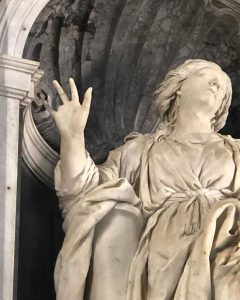
Bernini’s Santa Bibiana, with its missing finger — which has since been reattached. Image: Silvia Mosetti via NYT
DC’s Defunct Corcoran Gallery Announces the New Homes for Over 10,000 Works of Art
Four years after the gallery was abruptly closed, trustees of the institution have announced how more than 10,000 objects from its original $1 billion trove will be distributed. (artnet News)
No Pain, No Brain Gain: Why Learning Demands (A Little) Discomfort
Quality learning requires what brain scientists call “desirable difficulty.” (Fast Company)
Bloomberg Expands Arts Grant Program to Seven More Cities
Bloomberg Philanthropies is investing $43 million in more than 200 small and midsize cultural organizations. (New York Times)
The Risk of Moving Artworks: A Broken Finger and Public Outcry
An art history professor was taking a group of students through the baroque Church of Santa Bibiana when he made what he called a “macabre discovery.” (New York Times)
The Blueprint for Saudi Arabia’s Multi-Billion Euro Cultural Partnership with France
The ten-year deal gives France an exclusive role in an area almost the size of Belgium. (The Art Newspaper)
Soon You May Be Able to Text with 2,000 Egyptian Hieroglyphs
Over 2,000 new Hieroglyphs may soon be available for use on digital devices, thanks to collaboration between Egyptologists and digital linguistics. (Hyperallergic)
The Avant-Garde and the Global South, Artworks in Motion, and More in Art Journal
posted by CAA — May 15, 2018
“Proposition Avant-Garde: A View from the South,” by Geeta Kapur, the distinguished art critic, challenges readers of Art Journal to reconsider, reclaim, and rethink the idea of the avant-garde. The text by the Delhi–based Kapur appears for the first time in the Spring 2018 issue of the journal, along with responses from the scholars Saloni Mathur and Rachel Weiss.
Also featured in the recently published issue are two projects by artists whose works provide illusions of motion. For The Virtual Immigrant, Annu Palakunnathu Matthew created a flip-motion lenticular card, inserted in each copy of the journal, which reveals two interlaced portraits of a young call center worker in India, one image in the casual Western address she wears at work, where she speaks in an acquired American accent, the other in the traditional Indian clothing she wears on more formal occasions. Matthew’s project features multiple portraits of three other call center workers; by calling a toll-free number (844-984-7882) on the back of the card, readers can hear short recordings in which the workers speak about the two cultures they inhabit in the course of their lives.
In his project Material Motion, Eric Dyer exhibits works from the last dozen years based on the zoetrope, a form of animation devised in the nineteenth century. Stills featured on the cover and interior pages of the journal show the evolution of the idea in the artist’s hands, first in spinning sculptures that reveal dozens of tiny animated details—cyclists zooming through an urban landscape; umbrellas furling, unfurling, and passing through rows of people and other umbrellas. Dyer further extended the zoetrope principle in numerous other animated pieces, including two DIY pieces that Art Journal readers can complete with a record turntable and a smartphone app.
The issue features three long-form scholarly essays: the curator Luigia Lonardelli on the unfolding of the 1973 Contemporanea, a massive multidisciplinary exhibition staged in an underground parking lot in Rome; Nika Elder on the repeated appearance of a seemingly simple shift dress in the 1980s–90s photographs of Lorna Simpson, a garment closely examined here for the first time; and Steven Jacobs on a 1960 film by Luc de Heusch in which René Magritte extended his artistic project through cinematic means, gnomically restaging some of his best-known paintings in his home.
The Reviews section opens with Joe Madura’s assessment of the exhibition and catalogue for Art, AIDS, America, with a special focus on the final iteration of the traveling show in Chicago. The section continues with reviews of Amy Bryzgel’s Performance Art in Eastern Europe (reviewed by Adair Rounthwaite), Jenni Sorkin’s Live Form: Women, Ceramics, and Community (by Glenn Adamson), and Jane McFadden’s Walter De Maria: Meaningless Work (by Amanda Boetzkes).
CAA sends print copies of Art Journal to all institutional members and to those individuals who choose to receive the journal as a benefit of membership. The digital version at Taylor & Francis Online is currently available to all CAA individual members regardless of their print subscription choice.
Want to see more? Join CAA today and explore the Spring issue in full.
Show Your Support for the Arts and Humanities
posted by CAA — May 14, 2018
With an ever-changing academic and museum landscape, it’s clear that CAA must respond to the evolving needs of its members. We can no longer be an organization satisfied only with producing a large annual conference and quarterly journals. We must be a leader in the national conversation about the future of art history and studio arts education; indeed we can work to strengthen all humanities departments in colleges and universities. In addition, the CAA Annual Conference needs to be a supportive environment where everyone can connect as colleagues and friends year round, and to do this, we need your help.
As the world’s largest international visual arts association, we can unite to bridge the generational divide in the field and create a sense of belonging for younger members. We can understand where barriers exist and find ways to break them down. We can provide leadership to solve diversity and inclusion issues on college campuses.
It is our goal to make sure everyone who has a stake in the visual arts, from practicing artists to teachers of art, art history, design, curatorial studies, and museum practices at the college level—at every organization from the loftiest research institution to the most rural community college—feel included and welcomed.
Please consider making a tax-deductible donation that will help the next generation of art historians and visual artists. Your support directly goes to travel scholarships, publications, and reduced membership and registration for student and independent members. Together, we can work to provide everyone in the field the essential resources, contacts, mentorship, and advocacy they need.
Thank you for your generosity and with my best wishes,
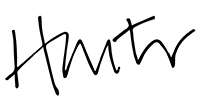
Hunter O’Hanian
Executive Director and CEO
Robert Howsare and Zach Fitchner
posted by CAA — May 14, 2018
The weekly CAA Conversations Podcast continues the vibrant discussions initiated at our Annual Conference. Listen in each week as educators explore arts and pedagogy, tackling everything from the day-to-day grind to the big, universal questions of the field.
This week, Robert Howsare and Zach Fitchner discuss teaching printmaking.
Robert Howsare is an Assistant Professor of Art teaching printmaking and foundation courses at West Virginia Wesleyan College.
Zach Fitchner is a printmaking artist and Assistant Professor of Art at West Virginia State University.
New in caa.reviews
posted by CAA — May 11, 2018
Adam R. Stead reviews The Gothic Screen: Space, Sculpture, and Community in the Cathedrals of France and Germany, ca.1200–1400 by Jacqueline Jung. Read the full review at caa.reviews.
Jared Sexton writes about Migrating the Black Body: The African Diaspora and Visual Culture edited by Leigh Raiford and Heike Raphael-Hernandez. Read the full review at caa.reviews.
Do You Know a CAA-Friendly Person Who Knows Numbers?
posted by CAA — May 11, 2018
As you know, CAA is a non-profit organization. Last fall, our beloved Treasurer Jack Hyland passed away after more than twenty years of service to the Association. Board Member Peter Lukehart has agreed to serve as Interim Treasurer until a permanent new treasurer is found.
If you know someone, perhaps a spouse or friend of an existing CAA member, who knows their away around numbers (i.e., budgets, annual financial statements, etc.) who would be willing to serve the Association as its Treasurer, please contact Executive Director Hunter O’Hanian (HOHanian@collegeart.org). Elected by the Board of Directors, the Treasurer is a non-paid position and sits on the Board of Directors. He or she works closely with the Association’s CFO to review financial statements. It is estimated that this role takes approximately 5 hours of volunteer time per quarter, in addition to attendance at the Board of Directors meetings which are usually in February, May and October.
Environment in Practice: Artmaking through Crisis
posted by CAA — May 10, 2018
The following article was written in response to a call for submissions by CAA’s International Committee. It is by Frederico Câmara, artist and independent researcher, Sydney, Australia.
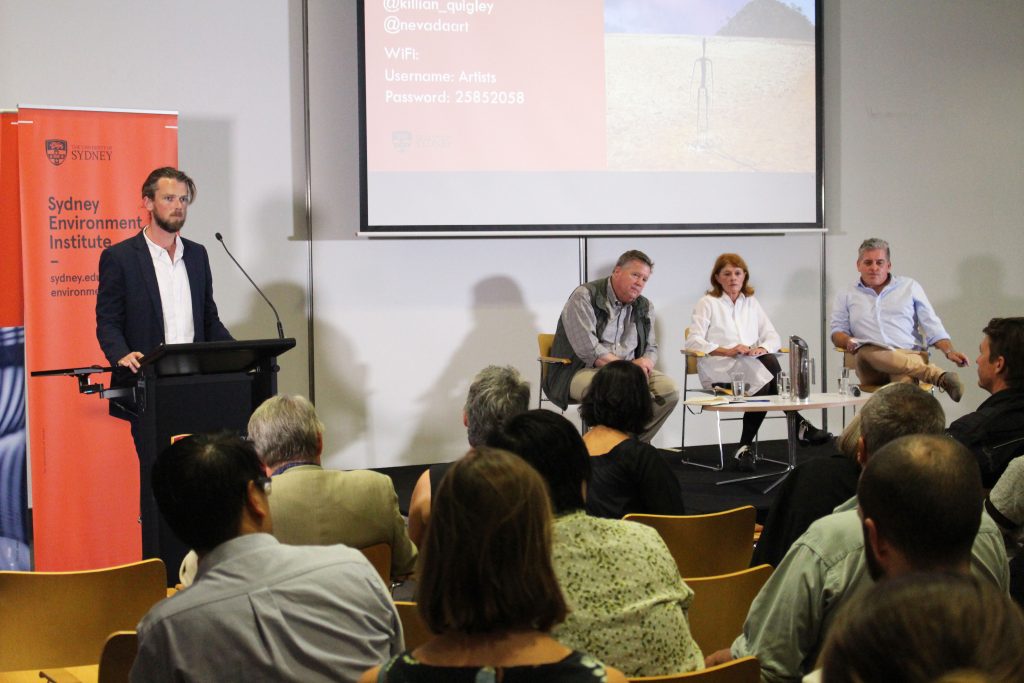
Fig. 1. Researcher Killian Quigley chairing a conversation between Bill Fox, Janet Laurence, and Ian Maxwell at the event Artists Have Never Been More Important, at the University of Sydney. Photograph: Eloise Fetterplace
Something very important for the planet is happening in Australia. As the Great Barrier Reef suffers from coral bleaching, and scientific evidence of global warming accumulates, the Sydney Environment Institute (SEI) raises the question: What can artists do in response to environmental crises?
The SEI at the University of Sydney addresses key environmental questions through discussion, research, and collaborations between artists, scientists, and humanists. This article discusses two recent international art events hosted by SEI to illustrate their work.
The first was held on March 27, 2018, at the University of Sydney. It featured William (Bill) L. Fox, Director of the Center for Art + Environment (CA+E) at the Nevada Museum of Art in a dynamic conversation with artists and members of the public on why “artists have never been more important”. This program was followed the next day, March 28, by the conference Environment in Practice: Artmaking Through Crisis, which gathered environmental activists, visual and sound artists, photographers, writers, musicians, and theater artists showing a wealth of artistic production that originates from, celebrates, and ultimately cares for the natural environment. In both events, participants were invited to exchange ideas on individual and communal artistic strategies to deal with the pressing environmental issues of today, through art.
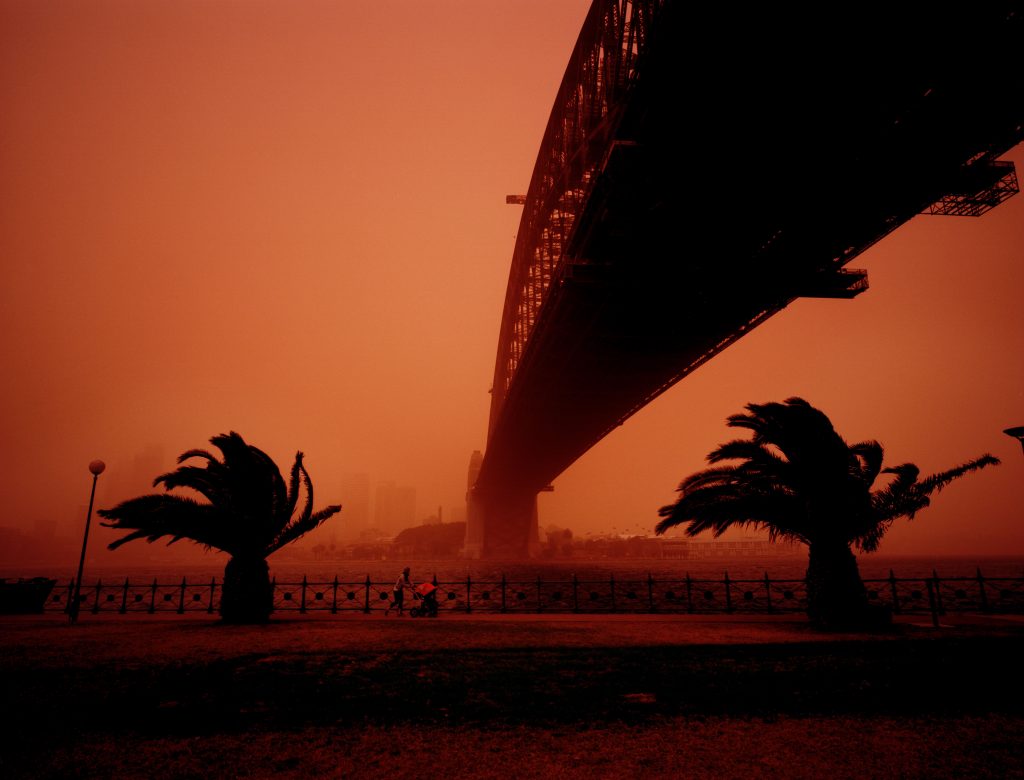
Fig. 2. Dean Sewell / Oculi, El Niño (ongoing). Photograph.
Bill Fox’s talk, Artists Have Never Been More Important, was a masterclass on artists working with the environment—as material, site, and subject—from well-known examples of American Land Art, to more environmentally conscious, if less spectacular, responses to various challenges involving humans and the natural world. It was interesting to note that those different approaches are not a sequential progression from one to the other. Both happened in the past, and are still happening now. Fox also introduced the work of the CA+E, an institution that collects the archives of artists working with the environment, and promotes research in the field. He concluded by proposing the idea of the artist as a bridge between scientists who collect evidence of climate change, and politicians who create and implement environmental policies. A lively conversation ensued with responses from artist Janet Laurence, theater theorist Ian Maxwell, SEI postdoctoral fellow Killian Quigley, and the audience, with one of its members arguing for a broader, less limited role of art in addressing the many crises that afflict our environment (Fig. 1).
This criticism is reflected in what the convenors called the “instrumentalization” of art in their introduction to the conference, questioning how artists will respond to the various invisible signs of environmental crises that defy representation and narration, including rises in temperatures, changes in the chemistry of oceans, and the scale of geological time. What are the possibilities for artmaking through environmental crises that will not reduce artistic practice to an instrument for the communication of scientific findings? Are artists capable of formulating their own questions, designing their own methods (including the collection of data during fieldwork), and producing and disseminating new knowledge and art that will criticize, reimagine, honor, and shape the world into a better place?
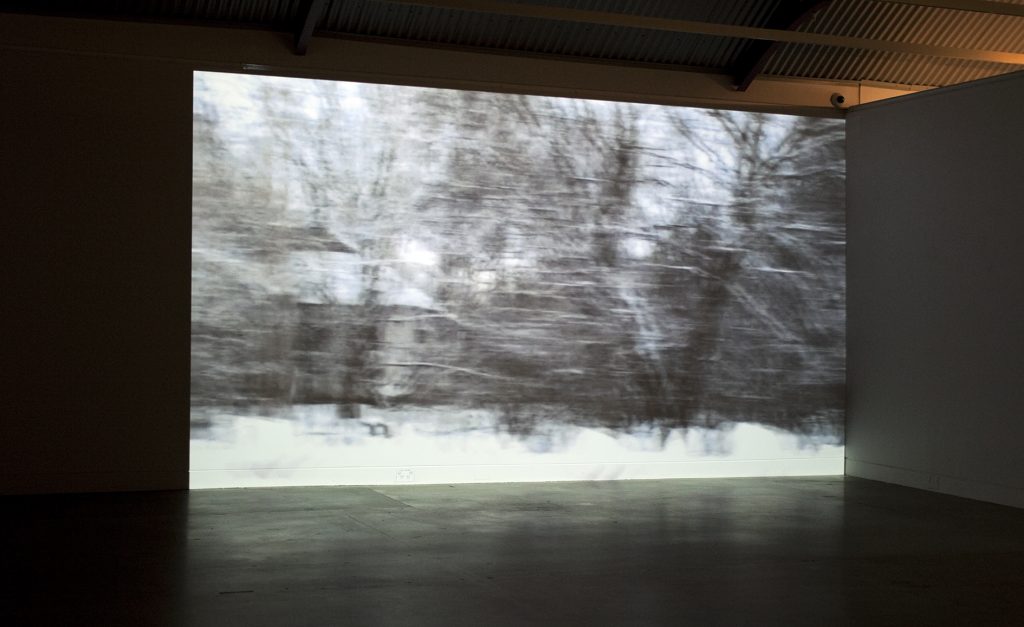
Fig. 3. Merilyn Fairskye, Fieldwork II (Chernobyl), 2009. Single-channel video, silent, 100 minutes.
The conference featured four thematic sessions, each one including artists working with a multitude of topics and methods. Session 1: “How Do Images Act,” began with David Ritter, CEO at Greenpeace Australia Pacific, who discussed the importance of images in the service of environmental activism and the challenges in using photography in an image-saturated world. He described his collaboration with photographer Dean Sewell who presented works at the conference on environmental issues affecting his native Australia and beyond (Fig. 2). The last speaker in this session was Merilyn Fairskye, an artist who travels the world in search of nuclear sites. She presented Fieldwork II (2009), a work filmed in Chernobyl that conveys the invisibility of nuclear evidence through the uncanny effect of movement at the level of pixels (or atoms?), as a symptom that that landscape is ill (Fig. 3).
Session 2: “Engaging Extremity,” started with sound artist Philip Samartzis presenting sounds that he documented during two scientific expeditions to Antarctica, creating an “overlooked” sound ethnography of the Australian presence on that continent. David Burrows then showed his stereoscopic photography in installations that transpose the Antarctic landscapes into the urban fabric of the city or the desert, demonstrating the idea of environmental unity where, apparently, there is none. Film theorist Belinda Smaill responded by remembering the participation of artists in the early navigations of discovery, linking their work to a contemporary, though decolonizing, environmental practice.
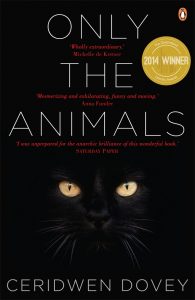
Fig. 4. Ceridwen Dovey, Only the Animals. Published by Penguin Random House Australia.
In Session 3: “Surpassing Humans,” writer Ceridwen Dovey presented her short story collection Only The Animals (2014), in which animals narrate their own deaths as a result of human conflicts, an exploration of the voice and consciousness of animals and a tribute not only to animals but also to other authors who have used a similar strategy (Fig. 4). Poet Judith Beveridge read two of her poems, highlighting the importance of metaphor as a tool for exploring relationships between humans and nature, and engendering in her readers a sense of wonder of the natural world. As she described it, she writes poetry “to give the natural world centrality” in an era of anthropocenic extinction.
In Session 4: “Composing Loss,” Genevieve Campbell, musician and music researcher, presented the project Ngarukuruwala – We Sing Songs, a musical collaboration with a group of senior song-women on the Tiwi Islands of Australia that emphasises the links between people, culture, and the land, and the need for preservation of both natural and cultural landscapes. Michelle St Anne performed My First Memory, a gripping monologue exploring the artist’s first memories and sensations of images, sounds and smells, to reflect on the domestic environment of her family home, perhaps as a metaphor for the natural environment as our collective home, and its disruption through conflict (Fig. 5).
The conference concluded with a discussion chaired by Killian Quigley on the possibilities for future developments and possible outputs. As the feminist and LGBT theorist Annamarie Jagose pointed out in her welcome speech, the conference itself, with its presentations and discussions, constituted one of the many forms that art can take as a practice that deals not only with the plights of the natural environment, but also recognises its capacity for wonder through beauty.
A full program and biographies of the speakers can be found here.
Podcast: Artists Have Never Been More Important
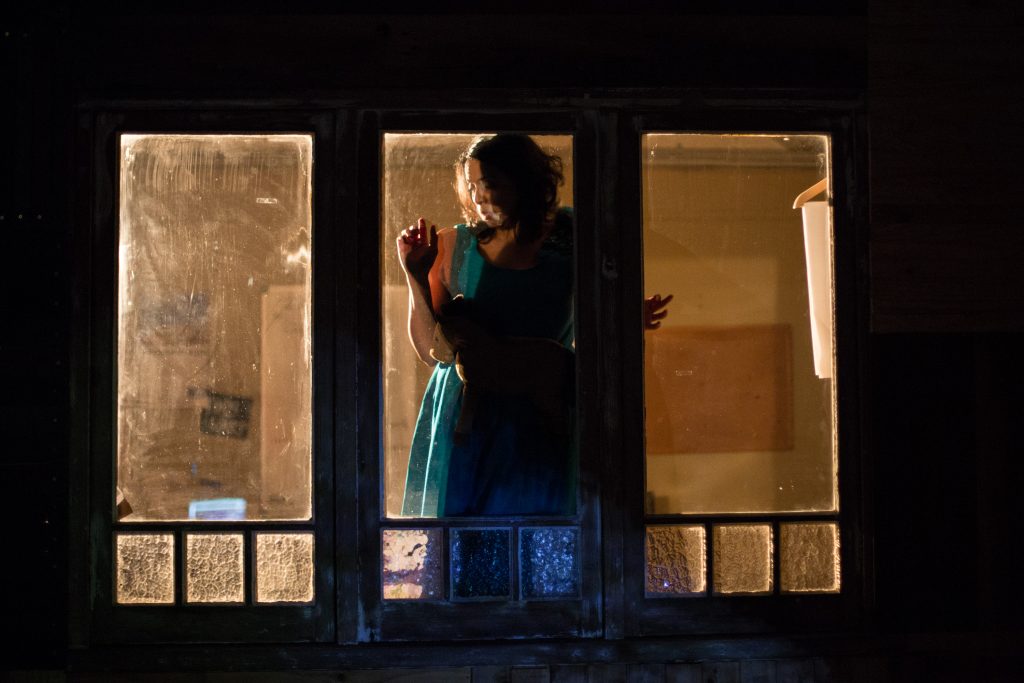
Fig. 5. Michelle St Anne performing “My First Memory” in I Love Todd Sampson (redux) at 107 Projects, Sydney, Australia. Photography: Clare Hawley



